Spring Security hello world example
2015-09-22 15:58
555 查看
In this tutorial, we will show you how to integrate Spring Security with a Spring MVC web application to secure a URL access. After implementing Spring Security, to access the content of an “admin” page, users need to key in the correct “
Technologies used :
Spring 3.2.8.RELEASE
Spring Security 3.2.3.RELEASE
Eclipse 4.2
JDK 1.6
Maven 3
Note
Spring Security 3.0 requires Java 5.0 Runtime Environment or higher
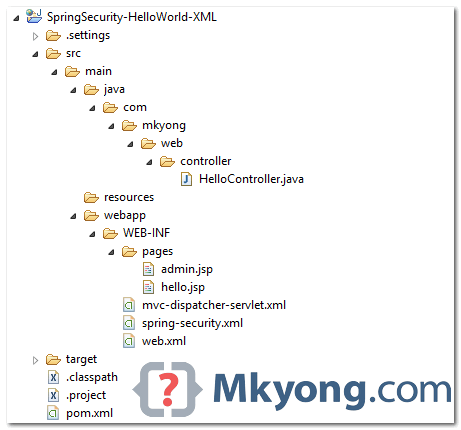
If URL =
If URL =
Later, we will show you how to use Spring Security to secure the “
Two JSP pages.
It tells, only user “
Welcome Page – http://localhost:8080/spring-security-helloworld-xml/welcome
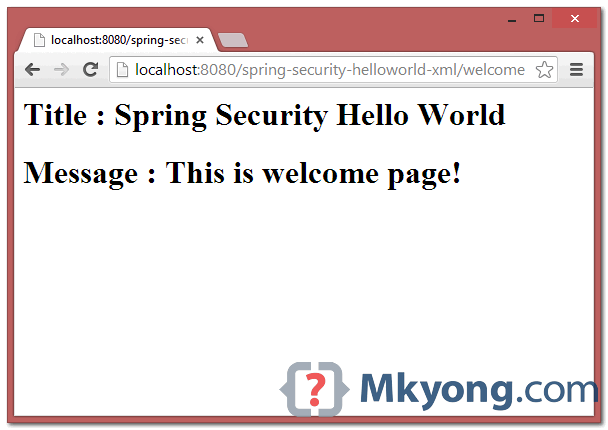
2. Try to access /admin page, Spring Security will intercept the request and redirect to /spring_security_login, and a predefined login form is displayed.
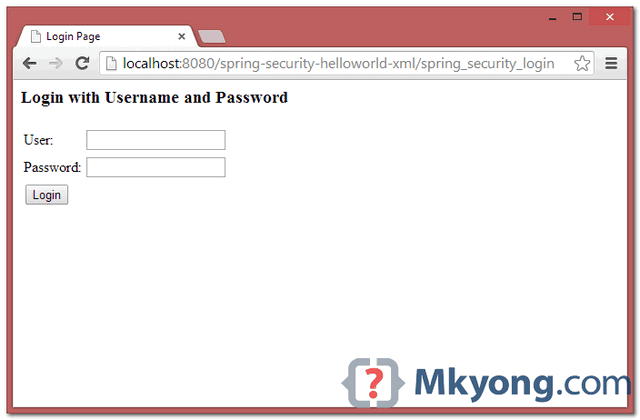
3. If username and password is incorrect, error messages will be displayed, and Spring will redirect to this URL /spring_security_login?login_error.
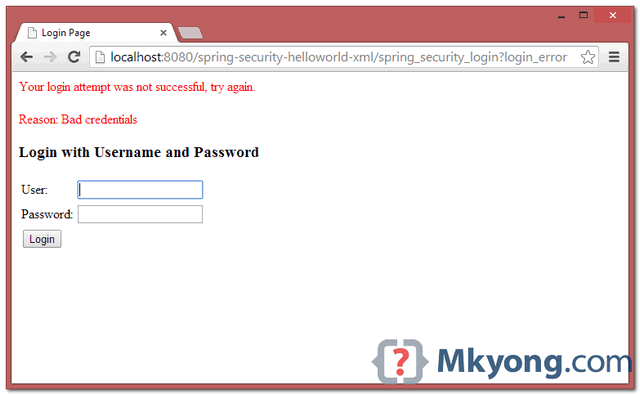
4. If username and password are correct, Spring will redirect the request to the original requested URL and display the page.
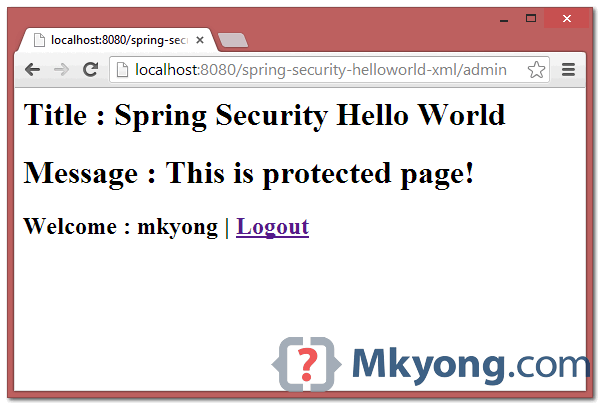
username” and “
password”.
Technologies used :
Spring 3.2.8.RELEASE
Spring Security 3.2.3.RELEASE
Eclipse 4.2
JDK 1.6
Maven 3
Note
Spring Security 3.0 requires Java 5.0 Runtime Environment or higher
1. Project Demo
2. Directory Structure
Review the final directory structure of this tutorial.
3. Spring Security Dependencies
To use Spring security, you needspring-security-weband
spring-security-config.
pom.xml
<properties>
<jdk.version>1.6</jdk.version>
<spring.version>3.2.8.RELEASE</spring.version>
<spring.security.version>3.2.3.RELEASE</spring.security.version>
<jstl.version>1.2</jstl.version>
</properties>
<dependencies>
<!-- Spring dependencies -->
<dependency>
<groupId>org.springframework</groupId>
<artifactId>spring-core</artifactId>
<version>${spring.version}</version>
</dependency>
<dependency>
<groupId>org.springframework</groupId>
<artifactId>spring-web</artifactId>
<version>${spring.version}</version>
</dependency>
<dependency>
<groupId>org.springframework</groupId>
<artifactId>spring-webmvc</artifactId>
<version>${spring.version}</version>
</dependency>
<!-- Spring Security -->
<dependency>
<groupId>org.springframework.security</groupId>
<artifactId>spring-security-web</artifactId>
<version>${spring.security.version}</version>
</dependency>
<dependency>
<groupId>org.springframework.security</groupId>
<artifactId>spring-security-config</artifactId>
<version>${spring.security.version}</version>
</dependency>
<!-- jstl for jsp page -->
<dependency>
<groupId>jstl</groupId>
<artifactId>jstl</artifactId>
<version>${jstl.version}</version>
</dependency>
</dependencies>4. Spring MVC Web Application
A simple controller :If URL =
/welcomeor
/, return
hellopage.
If URL =
/admin, return
adminpage.
Later, we will show you how to use Spring Security to secure the “
/admin” URL with a user login form.
HelloController.java
package com.mkyong.web.controller;
import org.springframework.stereotype.Controller;
import org.springframework.web.bind.annotation.RequestMapping;
import org.springframework.web.bind.annotation.RequestMethod;
import org.springframework.web.servlet.ModelAndView;
@Controller
public class HelloController {
@RequestMapping(value = { "/", "/welcome**" }, method = RequestMethod.GET)
public ModelAndView welcomePage() {
ModelAndView model = new ModelAndView();
model.addObject("title", "Spring Security Hello World");
model.addObject("message", "This is welcome page!");
model.setViewName("hello");
return model;
}
@RequestMapping(value = "/admin**", method = RequestMethod.GET)
public ModelAndView adminPage() {
ModelAndView model = new ModelAndView();
model.addObject("title", "Spring Security Hello World");
model.addObject("message", "This is protected page!");
model.setViewName("admin");
return model;
}
}Two JSP pages.
hello.jsp
<%@page session="false"%>
<html>
<body>
<h1>Title : ${title}</h1>
<h1>Message : ${message}</h1>
</body>
</html>admin.jsp
<%@taglib prefix="c" uri="http://java.sun.com/jsp/jstl/core"%>
<%@page session="true"%>
<html>
<body>
<h1>Title : ${title}</h1>
<h1>Message : ${message}</h1>
<c:if test="${pageContext.request.userPrincipal.name != null}">
<h2>Welcome : ${pageContext.request.userPrincipal.name}
| <a href="<c:url value="/j_spring_security_logout" />" > Logout</a></h2>
</c:if>
</body>
</html>mvc-dispatcher-servlet.xml
<beans xmlns="http://www.springframework.org/schema/beans" xmlns:context="http://www.springframework.org/schema/context" xmlns:xsi="http://www.w3.org/2001/XMLSchema-instance" xsi:schemaLocation=" http://www.springframework.org/schema/beans http://www.springframework.org/schema/beans/spring-beans-3.0.xsd http://www.springframework.org/schema/context http://www.springframework.org/schema/context/spring-context-3.0.xsd"> <context:component-scan base-package="com.mkyong.*" /> <bean class="org.springframework.web.servlet.view.InternalResourceViewResolver"> <property name="prefix"> <value>/WEB-INF/pages/</value> </property> <property name="suffix"> <value>.jsp</value> </property> </bean> </beans>
5. Spring Security : User Authentication
Create a Spring Security XML file.spring-security.xml
<beans:beans xmlns="http://www.springframework.org/schema/security" xmlns:beans="http://www.springframework.org/schema/beans" xmlns:xsi="http://www.w3.org/2001/XMLSchema-instance" xsi:schemaLocation="http://www.springframework.org/schema/beans http://www.springframework.org/schema/beans/spring-beans-3.0.xsd http://www.springframework.org/schema/security http://www.springframework.org/schema/security/spring-security-3.2.xsd"> <http auto-config="true"> <intercept-url pattern="/admin**" access="ROLE_USER" /> </http> <authentication-manager> <authentication-provider> <user-service> <user name="mkyong" password="123456" authorities="ROLE_USER" /> </user-service> </authentication-provider> </authentication-manager> </beans:beans>
It tells, only user “
mkyong” is allowed to access the
/adminURL.
6. Integrate Spring Security
To integrate Spring security with a Spring MVC web application, just declaresDelegatingFilterProxyas a servlet filter to intercept any incoming request.
web.xml
<web-app id="WebApp_ID" version="2.4" xmlns="http://java.sun.com/xml/ns/j2ee" xmlns:xsi="http://www.w3.org/2001/XMLSchema-instance" xsi:schemaLocation="http://java.sun.com/xml/ns/j2ee http://java.sun.com/xml/ns/j2ee/web-app_2_4.xsd"> <display-name>Spring MVC Application</display-name> <!-- Spring MVC --> <servlet> <servlet-name>mvc-dispatcher</servlet-name> <servlet-class>org.springframework.web.servlet.DispatcherServlet </servlet-class> <load-on-startup>1</load-on-startup> </servlet> <servlet-mapping> <servlet-name>mvc-dispatcher</servlet-name> <url-pattern>/</url-pattern> </servlet-mapping> <listener> <listener-class>org.springframework.web.context.ContextLoaderListener </listener-class> </listener> <!-- Loads Spring Security config file --> <context-param> <param-name>contextConfigLocation</param-name> <param-value> /WEB-INF/spring-security.xml </param-value> </context-param> <!-- Spring Security --> <filter> <filter-name>springSecurityFilterChain</filter-name> <filter-class>org.springframework.web.filter.DelegatingFilterProxy </filter-class> </filter> <filter-mapping> <filter-name>springSecurityFilterChain</filter-name> <url-pattern>/*</url-pattern> </filter-mapping> </web-app>
7. Demo
That’s all, but wait… where’s the login form? No worry, if you do not define any custom login form, Spring will create a simple login form automatically.Welcome Page – http://localhost:8080/spring-security-helloworld-xml/welcome

2. Try to access /admin page, Spring Security will intercept the request and redirect to /spring_security_login, and a predefined login form is displayed.

3. If username and password is incorrect, error messages will be displayed, and Spring will redirect to this URL /spring_security_login?login_error.

4. If username and password are correct, Spring will redirect the request to the original requested URL and display the page.

相关文章推荐
- 一个jar包里的网站
- 一个jar包里的网站之文件上传
- 一个jar包里的网站之返回对媒体类型
- spring+html5实现安全传输随机数字密码键盘
- Spring中属性注入详解
- struts2 spring整合fieldError问题
- spring的jdbctemplate的crud的基类dao
- 读取spring配置文件的方法(spring读取资源文件)
- java实现简单美女拼图游戏
- java基本教程之线程休眠 java多线程教程
- JSP开发中在spring mvc项目中实现登录账号单浏览器登录
- 基于Spring框架的Shiro配置方法
- Spring MVC中上传文件实例
- spring aop两种配置方式
- 实例讲解Java的Spring框架中的AOP实现
- 解析Java中如何获取Spring中配置的bean
- Spring的注解配置与XML配置之间的比较
- java Spring整合Freemarker的详细步骤
- Java 二维码,QR码,J4L-QRCode 的资料整理
- java当中的定时器的4种使用方式
